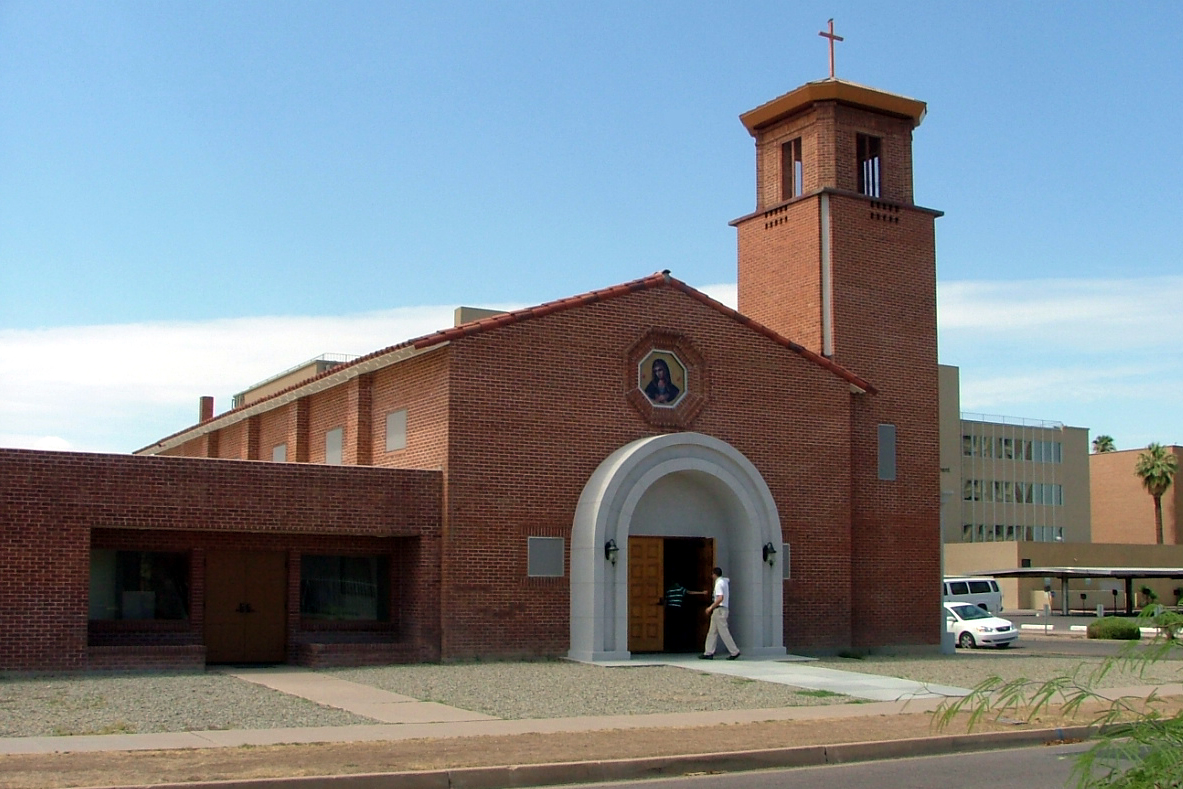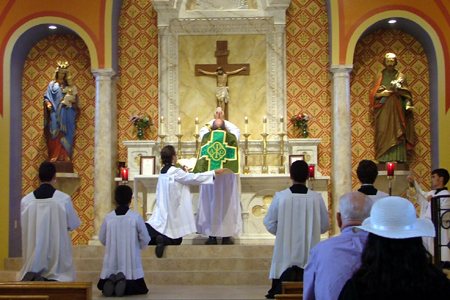| |
 |
 |
 |
| Comment on this report, or find other reports. |
 |
| Our Mystery Worshippers are volunteers who warm church pews for us around the world. If you'd like to become a Mystery Worshipper, start here. |
 |
| Find out how to reproduce this report in your church magazine or website. |
|
|
| 2217: Mater
Misericordiae Mission, Phoenix, Arizona, USA |
 |
 |
 |
Mystery
Worshipper: Amanda B. Reckondwythe.
The church:
Mater
Misericordiae Mission, Phoenix, Arizona, USA.
Denomination:
Roman Catholic,
Diocese
of Phoenix. The Mission is administered by members of the
Priestly Fraternity
of St Peter, North American District. The Fraternity, quoting
from its website, seeks "to reunite those who have been
alienated by liturgical abuse and theological dissent by offering
the sacred liturgy in all of its solemnity according to the
Latin liturgical books of 1962, and by offering the faithful
sound catechetical teaching."
The building:
Formerly a Baptist church, the present structure was acquired
by the Mission in 2010 and extensively renovated. It is a plain
red brick building with no signboard or other indication of
its name or denomination on the outside. Inside, the brick walls
have been painted white and beige and are lined with stations
of the cross, and the ceiling is of light colored wooden ribbing.
The windows are of plain frosted glass. In the sanctuary, six
steps rise up to the eastward facing altar, which is backed
by a crucifix and flanked by statues of the Blessed Mother and
St Joseph. The opening words of the hymn Salve Regina, mater
misericordiae appear on the archway over the sanctuary.
The altar was set for mass according to the old standard: altar
cards in place, the missal standing open on the epistle side,
the veiled chalice in the middle with ciborium tucked in to
its right and slightly behind, and the burse resting against
a candlestick.
The church:
The Mission celebrates mass in Latin according to the 1962 Missale
Romanum. They are active in the pro-life movement, having
participated in marches and rallies. They regularly station
sidewalk counselors in front of local abortion clinics. Among
the organizations that they sponsor are the Society of St Joseph
and Confraternity of Christian Mothers. There are two masses
each Sunday, low and sung, as well as a morning and evening
mass each weekday. The sacraments of baptism and holy matrimony
are administered on request upon completion of required preparation
classes.
The neighborhood:
Downtown Phoenix is awash in contradictions. For most of the
first half of the 20th century, Phoenix was the commercial hub
of the southwestern United States, but the downtown area gradually
fell to seed as the century waned. Extensive urban renewal has
transformed it into a modern oasis of glass and steel skyscrapers,
hotels, hospitals and sports arenas, most of which appear decidedly
unwelcoming to the pedestrian. The fringes of downtown, however,
are still replete with cheap motels, liquor stores, rescue missions
and vacant shops, the domain of the homeless and the downtrodden.
Mater Misericordiae Mission sits at Monroe Street and 15th Avenue,
not far from the Arizona state capitol. The immediate neighborhood
consists of railroad yards and warehouses.
The cast: The Revd Joseph Terra, FSSP, pastor, was the celebrant. The Revd John Shannon, FSSP, assistant, delivered the sermon and helped with the distribution of communion.
The date & time: Sixth Sunday after Pentecost, July 24, 2011, 11.00am.
What was the name of the service?
Sung Mass.
How full was the building?
I counted room for 200 and it was about two-thirds full – mostly a young adult crowd. The women covered their heads either with hats or chapel veils.
Did anyone welcome you personally?
No.
Was your pew comfortable?
Yes – standard wooden pew with kneeler.
How would you describe the pre-service
atmosphere?
People entered quietly and knelt in prayer. About a dozen people
stood in a side aisle waiting their turn to enter the confessional.
The organist played softly. About a minute before mass time,
an acolyte emerged to light the "high six" candles
on the altar, and I’m pleased to report he did it properly:
starting on the epistle side with the candle closest to the
tabernacle.
What were the exact opening words of the
service?
"Asperges me, Domine, hyssopo et mundabor" (You will
sprinkle me, o Lord, with hyssop, and I shall be cleansed.)
What books did the congregation use during the
service?
Only a very nicely produced notice sheet containing the schedule
for the week, mass readings, and a color reproduction (suitable
for framing) of The Holy Family with St Ann by the
Spanish Renaissance painter Nicolás Borrás. I wondered if every
week’s bulletin featured such a painting. Many people had brought
their own missals with them.
What musical instruments were played?
A beautifully voiced little pipe organ in the gallery. The mass
was sung by a schola cantorum of four men vested in cassock
and surplice who also sat in the gallery. The organist played
before mass, during the offertory and at communion, but the
schola sang a cappella. The organist’s offertory selection
was one of Mozart’s charming little church sonatas.
Did anything distract
you?
Memories of how things used to be 50 years ago kept flooding
into my head: the Introibo and Confiteor said
at the foot of the altar as mass began; the changing of the
book; communion on the tongue with paten held under the chin;
etc. The master of ceremonies looked very much like a friend
who was born in Germany of Afghan parents and who, of course,
is Muslim. I’ll call the M/C Faisal, as that is my friend’s
name. Only Faisal assisted the priest at mass – the other members
of the rather large altar party stayed on the sidelines for
the most part – but he performed his duties masterfully, bowing
and kissing just as they did in the old days. He even kissed
Father’s biretta whenever he handed it to him. When Father sat
at the sedilia, Faisal stood at his side with folded hands and
downcast eyes. When Father removed his biretta at the appropriate
times (e.g., at the words "suscipe deprecationem nostram"
during the Gloria), Faisal turned to face the altar. Faisal
also had a big surprise in store for me, which I’ll get to later.

Was the worship stiff-upper-lip,
happy clappy, or what?
A by-the-book Latin missa cantata according to the
1962 Missale Romanum. At precisely 11.00 the sacristy
bell was rung and the altar party processed up the aisle: crucifer,
acolytes, and Faisal the M/C in cassocks and surplices, and
the celebrant in alb, crossed stole, maniple (yes!), green cope
and biretta. The celebrant then intoned the Asperges,
which the choir took up as he walked up and down the aisle sprinkling
left and right, with Faisal holding back his cope. That done,
the celebrant exchanged the cope for a green Gothic chasuble
and the thurifer emerged from the sacristy with thurible and
boat (interestingly, the thurible was not carried in procession)
for the first censing. The schola cantorum sang the Gregorian
Chant settings of the propers, and the Missa de Angelis
setting of the ordinary. The Confiteor was repeated
just before communion, and the Last Gospel was recited at the
end of mass. The whole thing really was a time warp.
Exactly how long was the sermon?
11 minutes.
On a scale of 1-10, how good was the preacher?
7 – Father Shannon delivered a scholarly and well-researched exposition on the day’s readings: Romans 6:3-11 (by Jesus’ death we are dead to sin) and Mark 8:1-9 (Jesus feeds the multitudes). Although he spoke clearly, he read his sermon from notes. But he’s a young man – perhaps with time he’ll learn to preach rather than read.
In a nutshell, what was the sermon
about?
Baptism is the gateway to all the other sacraments. There are
two forms of baptism: pouring and immersion. Baptism by immersion
more clearly symbolizes Christ’s death and resurrection. Before
baptism, the soul is in bondage to the devil; that’s why so
much of the baptism ceremony sounds like a mini-exorcism. After
baptism the soul is completely free of sin and incorporated
into the Mystical Body of Christ. But our fallen nature remains,
and so we must strengthen our struggle against sin through the
eucharist. If we persevere, we will at last arrive at heaven,
our true homeland.
Which part of the service was like being in
heaven?
Just imagining myself transported back 50 years in time was
heaven enough. Everything was so perfectly done. I especially
enjoyed witnessing those little touches that are no longer a
part of the novus ordo mass, e.g. the thurifer censing
the master of ceremonies and acolytes in choir at the second
censing; the priest blessing the water cruet as he made his
chalice; all of the solita oscula (customary kisses);
etc.
And which part was like being in... er... the other place?
Nothing, really, although if I must nitpick, I do wonder why the swarm of acolytes remained on the sidelines for most of the mass, leaving Faisal to assist the priest by himself. And even though the schola cantorum consisted only of four men, I would have liked to hear them try a Palestrina or Victoria motet at the offertory or communion. (The Mozart church sonata was a treat, though, that we don’t often hear.)
What happened when you hung around after the service looking lost?
The altar party recessed down the aisle as the schola sang the
Gregorian setting of Salve Regina, mater misericordiae.
As the party passed my pew, I realized to my surprise that one
of the acolytes was Faisal’s twin brother. I hadn’t noticed
that earlier. As I was leaving, a lady said to me, "What
publication do you write for?" Uh-oh! My cover was blown!
I told her a little about the Ship and made her promise to go
on-line to check out my report. We talked a bit about the Latin
mass and how it brought back memories.
How would you describe the after-service
coffee?
There was none.
How would you feel about making this church your regular (where 10 = ecstatic, 0 = terminal)?
5 – As well done as this service was, and as pleasant as it was to travel back in time if only for an hour, when all is said and done I think I prefer the mass in the vernacular facing the people.
Did the service make you feel glad to be a
Christian?
Yes.
What one thing will you remember about all this in seven days' time?
How much the master of ceremonies resembled my friend Faisal – and that the M/C has a twin brother! |
|
|
 |
 |
 |
| We rely on voluntary donations to stay online. If you're a regular visitor to Ship of Fools, please consider supporting us. |
 |
 |
 |
| The Mystery Pilgrim |
 |
| One of our most seasoned reporters makes the Camino pilgrimage to Santiago de Compostela in Spain. Read here. |
 |
 |
 |
| London churches |
 |
| Read reports from 70 London churches, visited by a small army of Mystery Worshippers on one single Sunday. Read here. |
| |
|
|
|
|


